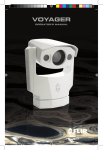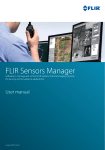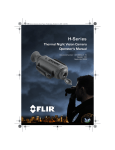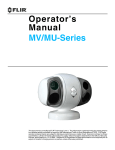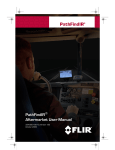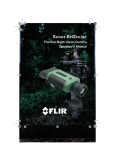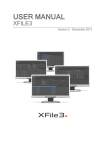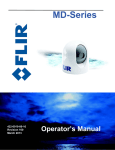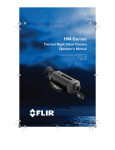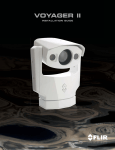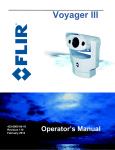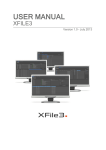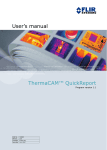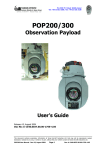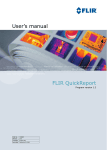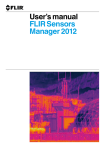Download Flir Sensors Manager Users Manual
Transcript
FLIR Sensors Manager Software to manage and control FLIR Systems thermal imaging cameras for security and surveillance applications User manual www.flir.com FLIR Sensors Manager User Manual Prepared for: FLIR Networked Systems Prepared by: FLIR Networked Systems Approved: Product Manager Authorization: Document Code: MAN-IT-2008-003 Revision: 1.8 Date: September, 2009 Internal Code: MT1003/2008v1.8 FLIR Networked Systems. Av. Bruselas 6 - B2 28109 Alcobendas (Madrid) - Spain Tel: +34 (91) 490 40 60 Fax: +34 (91) 662 97 48 PROPRIETARY INFORMATION © FLIR Networked Systems, 2009 This document may only be reproduced partially or completely, archived, photocopied or transmitted in any way through electronic media with previous written permission from FLIR Networked Systems. It shall also be referenced when used as a source of information. 3 4 DOCUMENT STATUS Version 1.0 1.1 1.2 Date 07/18/2008 10/28/2008 01/12/2009 Pages 29 29 63 1.3 06/2/2009 68 1.3.1 06/02/03 81 1.4 06/05/2009 82 1.5 07/03/2009 82 1.6 08/10/2009 94 1.7 08/21/2009 128 1.8 09/02/2009 128 Change(s) Revised Initial Version Minor changes Video Wall section updated NDVR section added Surveillance Monitor section added Image Post Processing section added Users Management section added Advanced Control Manager section added. Joystick management section added Other minor changes VPU section added Alarms Manager section added Panorama section added License management section added. Log section added. NMEA Monitor section added. Alarm Monitor section added. Ruler and Zoom box cursor modes description added to Map section. Profile Manager section added. Radars Tracks Panel section added. Control Panel section added. Video Toolbar description updated. Images updated. Installation instructions added Setting up User Accounts Document formatted. Licenses section updated. Document’s scope section updated. Minor changes. Licenses manager updated. Appendix sections added. Shortcut List added. Added new functions. Expanded section on video wall configuration. Added and replaced several screen shots for the map functions. 5 6 TABLE OF CONTENTS 1 Introduction 2 Nexus Overview 3 FSM Licenses 4 FLIR Sensors Manager Installation 5 FSM Operation 5.1 Server discovery 5.2 Disabling Automatic Sensor Discovery 5.3 Server status and basic management 5.3.1 Sensors Panel 5.3.2 Control Panel 5.4 Licenses Management 5.4.1 Upgrading Text Licenses 5.4.2 Upgrading Licenses in a USB Dongle 5.5 Application Preferences 5.6 Windows Options 5.6.1 “Always on Top” Window 5.7 Toolbar 5.8 Joystick Setup 5.9 Map loading and calibration 5.9.1 Map basic controls 5.9.2 Map load 5.9.3 Map calibration 5.9.4 Sensor Georeference 5.9.5 Map Rotation 5.9.6 Map Background Opacity 5.9.7 Sensors Display 5.9.8 Sensor Management 5.10 Video Wall Setup 5.10.1 Basic Setup 5.10.2 Clearing a Video Wall 5.10.3 Setting up Video Post Processing (VPP) 11 11 11 12 14 15 16 17 17 19 20 20 21 21 22 22 23 24 25 25 26 28 33 36 37 39 44 45 46 51 51 7 TABLE OF CONTENTS 5.10.4 Setting up the Video Statistics 5.10.5 File Playback 5.10.6 Frame Grabber Playback 5.10.7 Video Playback Management 5.10.8 Video Profiles Management 5.10.9 Cursor Modes 5.10.10 Area Edition 5.11 Log 5.12 NMEA Monitor 5.13 Alarm Monitor 5.14 Scan Lists 5.15 Panorama 5.16 NDVR Management 5.17 VPU Management 5.18 Surveillance Monitor 5.18.1 Areas 5.18.2 VMD 5.18.3 Acquisition 5.18.4 Tracking 5.18.5 Alarms 5.19 Image Post-Processing 5.19.1 Filters 5.19.2 Stabilization 5.20 Alarms Manager 5.21 Radars Tracks Panel 5.22 Users Management 5.23 Advanced Sensors Controls 5.24 Profile Manager 5.25 Media Manager 5.26 Sounds Manager 8 52 53 56 58 59 60 61 63 63 64 64 65 68 69 71 72 73 73 77 79 80 81 82 82 83 84 85 87 87 88 APPENDIX A: Electronic Stabilization 89 1 Introduction 2 Hardware Requirements 3 eStab Application Guidelines 3.1 Principle of Operation 3.2 eStab Control Panel in FLIR Sensors Manager. 3.3 Setting up the Stabilization ROI 3.3.1 Stabilization Example 1 3.3.2 Stabilization Example 2 3.3.3 Stabilization Example 3 3.4 Adjusting Amplitude Parameters 4 Additional Settings 4.1 Show Border 4.2 Contrast Enhancer 5 Troubleshooting and Limitations 5.1 Integration Time 5.2 CPU Usage 5.3 Limitations 5.3.1 Noisy video 5.3.2 Very low resolution video 89 89 89 89 90 90 91 91 92 92 92 92 92 92 92 93 93 93 93 APPENDIX B: Setting up the Surveillance Monitor 94 1 2 3 4 5 94 94 94 Introduction Items Required Setting up the environment Important concepts for VMD (Video Motion Detection) and Target Acquisition Setting up a surveillance system using VMD 5.1 Area Edition 94 96 96 9 5.2 Alarm monitoring 5.3 Fine tuning VMD parameters 6 Target Acquisition 6.1 Setting up a surveillance system using the Target Acquisition algorithms 6.2 Global Noise Filter Slider 6.3 Min and Max Size 6.4 Clustering target fragments into a single target 6.5 Acquisition and Drop Times 7 Profiles 8 Additional Target Acquisition algorithms 9 Summary of VMD and Target Acquisition Settings 102 105 105 107 109 110 112 114 APPENDIX C: Users and Workgroups 115 1 Setting up Users and Workgroups 1.1 Creating Accounts (Windows XP Professional) 1.2 Setting up User Groups (Windows Vista Professional) 1.2.1 Create a new user account 1.2.2 Add a user account to a group 1.3 Setting up User privileges 115 115 118 119 119 119 APPENDIX D: Shortcuts 120 GLOSSARY 121 10 99 100 101 1. Introduction This User Manual will familiarize you with the operation of a FLIR Sensors Manager (FSM) application, taking you through the most common operation steps. This document is based on a specific layout of FSM, and may differ from your actual application, but the components and operating steps are the same. 2. Nexus Overview Nexus is an excellent “plug- and- play” middleware tool to manage a wide variety of sensors, from very basic sensors to high-end, networked imaging integrated systems, including radars, DVRs, I/O sensors, ground sensors, etc. ` The Nexus is built over three main entities: - Server: the Server is connected to the devices turning them into network, hot plug-and-play devices. - Console: the Console is a client-side user interface for the sensor network. - Development Tools: the Development Tools are a group of software components that allow developers to easily code custom applications to manage and control the sensor network. These Development Tools are the following: o Map: the Map control provides functions to build a graphical geographic representation of the network. o Software Development Kit: the SDK provides a library including a set of functions to control the servers and get their current status. o Video Player: the Video Player provides functions to play video from different sources and to perform image post-processing and video analysis for surveillance. 3. FSM Licenses Some FLIR Sensors Manager features require a license to be available in the application. The available licenses and the features enabled are the following: • Demo License: that is, no license is loaded. When no license is loaded, command and control and one video per video wall are enabled. Only one sensor can be managed with the demo license. • Basic License: enables managing up to 4 sensors and the geo-mapping features. • Pro License: enables all the features: • Up to 4 sensors. • Geo-mapping. • Surveillance Monitor. • Image Post Processing. • Radar cueing and tracks display. • Video wall display. • Additional Sensor License: allows increasing the number of sensors that can be managed simultaneously (up to 50 per workstation). 11 4. FLIR Sensors Manager Installation To begin the installation process, insert the FLIR Sensors Manager CD in the desired PC. 1. Open the Installation CD and double click on the FSM Setup icon. The Installation Setup window opens. Click Next to continue. 2. Read the License Agreement and click I Agree to continue. In the next screen select the components you wish to install. Please note that FSM will not work if any of the components is not installed. Unselecting components in the installation is not recommended for inexperienced users. When in doubt, install everything: 12 3. When asked to choose the install location, click Install to accept the default location. If a different location is desired, click Browse to navigate to the location of your choice, then click Install. 4. The last component to be installed is the FLIR Video Player. Please note that the FSM application relies on this player and it will not function without it. 5. Click Next, read and accept the License Agreement and click Next again. 13 6. When the installation is complete, click Finish to close the installer. 5. FSM Operation The current FLIR Sensors Manager version is built using independent, self-contained modules that interact with others when these are present, but that can operate as stand-alone components. From one sensor control, to a multi sensor security network that could include IR and DLTV cameras, radars, and ground sensors, FLIR Sensors Manager is the one point solution for the control of your security sensors. Once installed, FLIR Sensors Managers offers a user friendly and straight forward interface that focus on usability and situational awareness. While minimizing operator workload to a minimum, FLIR Sensors Manager also allows full control of its complete suite of surveillance and video management capabilities. 14 5.1 Server discovery When FSM is run for the first time and there are no sensors connected or enabled, the screen will look like this: However, in most cases there will be at least one sensor connected already. The first time you run the application, the automated connection settings are turned on. When there is one sensor connected, it is added to the sensor’s list, connected to FSM and its video stream automatically opened in Video Wall 0. The discovery panel provides the functionality of adding servers to the active servers list. The servers can be added manually by entering the IP address and port of the server and clicking on the “Add” button or by performing a network server discovery by clicking on the “Refresh” button and adding the servers to the active servers list by clicking the “>” button. 15 Once the servers are on the active servers list, these will be displayed on the sensors panel: The discovery panel can now be collapsed by clicking on its label. 5.2 Disabling Preferences For ease of operation, FSM is set up to run out of the box by automatically discovering and connecting to one sensor, opening the video channel and requesting control of that sensor. This is very convenient if you are running a “one sensor, one user” environment, but it you run multiple sensors and work in a multiuser environment it may be useful to disable some or all of the Preferences. For instance, if the “Request Control of Active Sensor” is turned on and there are other users already controlling a sensor, they would lose control as FSM automatically grants it to you. Another example might be if you have set up a specific video wall. In this case it is important to turn off the “Open Active Server Video on Video Wall 0”, otherwise the previous video wall settings will be overridden by the automatic preferences. To do so changes the preferences, click Edit> Preferences and deselect/disabled the functions you do not want: 16 5.3. Server status and basic management Everything needed for basic sensor management is on the left side of the main window: the sensors panel and the control panel. 5.3.1 Sensors Panel The sensors panel provides a view of the servers’ status and allows performing several management operations. A connection with a server can be established by right-clicking on the server name: Once the server is connected, its status and the status of its devices are displayed: 17 The control of a connected server can be requested by selecting the “Request Control” option when right-clicking on its name. In some situations you may need to use Request Control (Forced), which is a request that cannot be denied by other users and effectively grants you control of the selected server: If necessary, it is possible to lock control so that any request coming from another user is automatically denied. Right-clicking over a DLTV or an IR sensor displays the “Send to” menu which allows opening the sensor’s video on one of the application’s video walls: Please note that double-clicking on the sensor requests control over that sensor and sets it as active. Hovering the mouse pointer over the sensor displays a tooltip with information on the sensor: 18 The information displayed contains the name of the server, the host identifier, its geolocation coordinates, and the status of the server (Stopped/Running or Unknown). Right clicking on the sensor brings up a context menu that also allows you to Stop/Start the server: 5.3.2 Control Panel The control panel allows performing the most common sensor commands: 1. Scan List Start. 2. Scan List Stop. 3. Go To Preset. 4. Initialize Pan and Tilt. 5. Home 6. Toggle Active Camera. 7. Zoom In. 8. Pan and Tilt Up. 9. Focus Far. 10. Pan and Tilt Left. 11. Show Pad. 12. Pan and Tilt Right. 13. Zoom Out. 14. Pan and Tilt Down. 15. Focus Near. 19 5.4 Licenses Management The licenses management module allows setting and checking the application licenses. The licenses manager can be displayed by clicking on the “View” menu button and selecting the “Licenses Manager” option: 1. 2. 3. 4. 5. 6. 7. 8. Get Id: displays the host identifier needed to generate a license string. Load License File: loads a text file into the licenses text box. Save License File: saves the contents of the licenses text box to the license file. Check Licenses: button checks the available licenses and displays the result of the check in the licenses check text box. The licenses text box displays the current license string. The dongle data fields display the current dongle data. If no dongle is plugged in, these will be disabled. Store: button stored the data in the dongle data fields in the dongle. The licenses check text box displays the result of the licenses check. 5.4.1 Upgrading Text Licenses In order to upgrade the text license, the license string provided by your FLIR representative (typically a “license.txt” file) must be copied and pasted into the licenses text box (item number 5) and saved by clicking on the “Save License File” button. 20 5.4.2 Upgrading Licenses in a USB Dongle In order to upgrade a USB dongle with additional licenses, the license key (text string containing six groups of numeric characters) provided by your FLIR representative must be typed in the dongle data fields (item number 6) and stored in the dongle clicking on the “Store” button. 5.5 Application Preferences The application preferences panel can be displayed by clicking on the “Edit” button of the main menu and selecting the “Preferences” option: The “Behavior” section allows setting the actions that will be performed on determined events upon start up. The “OSD” section allows setting the default OSD settings for the video configurations the user creates. The “Change Language” section allows setting the application’s language. The changes will be effective after restarting the application. In order to commit any change in the preferences, you must click the “Apply” button. 21 5.6 Windows Options Right-clicking on any window’s title bar displays a context menu that allows setting some options: The fit options will resize the window to fit either its content or the screen. The aspect ratio options ensure that the selected aspect ratio will be kept after a resize. The main menu toggling option is available only for the main window and it shows or hides the main menu. 5.6.1 “Always on Top” Window If you want to keep one particular window always visible, you can use the Always on Top option. To do so, right-click on the window frame and select Always on Top: 22 5.7 Toolbar The toolbar includes different sections with controls that display status data and allow managing different features. The displayed toolbar sections can be selected by right-clicking over it and selecting the appropriate section or item to be displayed or hidden. 23 5.8 Joystick Setup The joystick management module allows configuring the plugged joysticks to be used in the application: 1. 2. 3. 4. 5. Joystick selection combo box: selects the joystick to be configured. Save configuration button: stores the current configuration, making it active for the rest of the application. Axes configuration combo boxes: set the axes actions. Axes can be tested using the graphic bars beside the combo boxes. Button configuration combo boxes: sets the buttons’ actions, allowing setting different actions when the active camera is a DLTV and when the active camera is an IR. POV configuration combo boxes: sets the POVs’ actions, allowing setting different actions when the active camera is a DLTV and when the active camera is an IR. NOTE: the left column affects the IR camera and the right column affects DLTV. Also, pressing buttons on the joystick will auto-select that button in the menu for ease of configuration. 24 5.9 Map loading and calibration The map control provides the features of a Geographic Information System (GIS), combined with the sensors network’s management: Map control and mapped sensor features management are described in the following sections. 5.9.1 Map basic controls The map control is mainly managed using the computer mouse: - Left button click: left button click effects depend on the cursor mode o None: no effect. o Aim: the effect of clicking on the map with this cursor mode depends on the type of the active sensor. These features are described in the “Sensor management” section o Pan: allows map panning. o Zoom In: zooms in the map view. o Zoom Out: zooms out the map view. o Edit Area: the effect of clicking on the map with this cursor mode depends on the type of the active sensor. These features are described in the “Sensor management” section o Ruler: displays the distance between the selected points or objects. One of the ends is set by left-clicking on the map surface and the other is set by holding the “Shift” key while left-clicking. - Mouse wheel: zoom in and zoom out. - Right button click: show context menu. 25 MAP SHORTCUTS A Arrow cursor mode (no action) H Hand cursor mode (pan) R Reticule cursor mode (aim) Z/Shift+Z Mouse wheel Ctrl+mouse wheel Shift+mouse wheel Alt+Mouse Wheel zoom in/out cursor mode Zoom in/out Pan horizontally Pan vertically Map Rotation right Ctrl+R Alt+Mouse Wheel Ctrl+Shift+R Crtl+N B /Shift+B Map Rotation left Reset Rotation Map Opacity (increase/decrease) 5.9.2 Map load When the map control is not configured, it shows up as a black box: 26 1. 2. 3. Geographic coordinates: geographic coordinates of the point under the mouse position. Logo: FLIR logo Map surface: surface where the map will be displayed when loaded. To load a map, right-click on the map surface and select the map file in the “Load Background” menu: NOTE: In order to become calibrated maps, the image files used for FSM must be North-up and orthonormal. In order to be selectable, all map files must be placed in the maps folder of the application. This folder is, usually, “\<installation_folder>\map”. Currently, “.bmp” and “.jpg” image file formats are supported. 27 Once the map is loaded, it needs to be calibrated. 5.9.3 Map calibration The map calibration establishes a relation between the map file points and the geographical points, so that the sensors’ geographical management tasks can be performed using the map controls features. In other words, each point on the map image will have a corresponding geographical coordinate. To access the calibration mode, right-click over the map surface and select the “Map Background Calibration” option: 28 Once in the map calibration mode, the map calibration panel is displayed: 29 1. 2. 3. 4. 5. Calibration steps reminder: description of how the calibration process is performed. First point data: position of the first map point on the map file and the text fields to enter the corresponding geographical coordinates. Second point data: position of the second map point on the map file and the text fields to enter the corresponding geographical coordinates. Perform calibration button: commits the calibration data. Close link: closes the calibration panel at any time. The calibration process involves selecting two map points and providing the corresponding geographical data. NOTE: You must know the exact Longitude and Latitude for these two points. This can be acquired locally with a GPS, or by using readily available third party mapping software capable of displaying coordinates for any given point. 30 First, right-click on a point of the map for which you have the coordinates and select “Get Coordinates for Calibration Point 1”: NOTE: for accuracy in the calibration process it is important to select two distinct points as far from each other as possible. 31 Once a calibration point is selected, it is displayed on the map: Now, select a second point on the map by repeating the previous step and clicking on “Get Coordinates for Calibration Point 2.” 32 Once the two calibration points are selected and the corresponding geographical values set, click the “Perform Calibration” button to finish the calibration process. 5.9.4 Sensor Georeference To locate the existing sensor(s) on the map you need to georeference the sensor. The sensors’ georeference process can be performed in a few simple steps via the map control. NOTE: In order to georeference a sensor, it must be the active sensor and control must be owned. When these conditions are met, the georeference process can be initiated by right-clicking on the map surface and selecting the “Georeference Sensor” option: While in geo-referencing mode, the sensor georeference panel is displayed on the upper righthand corner: 33 1. 2. 3. 4. 5. 6. 7. 8. Active sensor name: displays the name of the sensor that is currently being georeferenced. Current sensor location: displays and allows modifying the sensor current location. Current sensor altitude: altitude in meters for the sensor. Current sensor heading: displays and allows modifying the sensor current heading. Current sensor leveling: displays and allows modifying the sensor current leveling. Save to sensor button: stores the current values in the sensor, thus actually performing the georeference. Restore from sensor button: retrieves the current georeference values stored in the sensor. Close link: allows closing the sensor georeference panel at any time. The sensor georeference can be set using the sensor georeference panel or by right-clicking on the map surface and selecting the “Get Coordinates for Sensor Georeference”: 34 Once the georeference values are committed by clicking on the “Save to sensor” button, the sensor will be displayed on the provided coordinates on the map: 35 Displaying a sensor on the map usually involves not just displaying an icon that stands for the sensor, but some additional graphics symbolizing some of the sensor status data. These are explained in the “Sensors display” section. 5.9.5 Map Rotation In some cases rotating the map may provide a better or more logical view of the area to survey. To rotate the map, use alt + mouse wheel, Ctrl + R/Ctrl + Shift + R. 36 To reset the map to its original position (North-up), you can use Ctrl+N, or right-click on the map and select Reset Rotation: 5.9.6 Map Background Opacity You can adjust the opacity of the map background if you need to see the sensors with more clarity. To do so, click on the map once, then press “B” to increase the opacity. The map will get dimmer and the sensors will stand out: 37 To decrease opacity, press Shift+B. 38 5.9.7 Sensors Display The sensors that can be displayed on the map usually have an associated set of graphics (depending on the sensor type) that stand for the sensor status data. 5.9.7.1 General Some of the map sensor status graphics are common to all sensor types: 1. 2. 3. 4. 5. Disconnected sensor icon: the disconnected sensors are grayed out, as in the “mserver” icon displayed on the upper left corner of the image above. Sensor name: the sensor name is displayed on the map surface below the sensor icon. Unknown sensor: Sensors for which there is no associated image are displayed on the map as a plain-colored dot. Active sensor ring: the active sensor is displayed on the map surface, surrounded by a plain-colored ring. Sensor summary: the sensor summary is displayed when placing the mouse over the sensor icon. 39 5.9.7.2 Cameras The camera-type sensors status graphics display the main status data, like the field of view value or the heading: 1. 2. 40 IR camera field of view: the IR cameras field of view is displayed in red, showing also the camera heading, on the map surface. DLTV camera field of view: the DLTV cameras field of view is displayed in blue, showing also the camera heading, on the map surface. 5.9.7.3 Radars The radar-type sensor status data is displayed on the map surface as shown below: 1. 2. 3. Scan sector: the radar scan sector is displayed in green on the map surface. Radar tracks: each radar track is displayed on the map surface including its identifier, as a text label beside it, and its history, as fading copies of the track on its previous positions. Radar track summary: the radar track summary is displayed when the mouse is placed over it. 41 5.9.7.4 I/O Sensors The I/O-type sensors are displayed on the map surface, including both the I/O box location and the sensors location: 1. 2. 3. 4. I/O box icon: the sensor icon displayed on the map shows the I/O box location. Sensors: the I/O sensors are displayed on the map as dots and an identifier label. Sensor in alarm status: when an input sensor is firing an alarm, it is shown on the map surrounded by a ring and the word “Alarm” can be read on its label. Sensor summary: the sensor status data summary is displayed when the mouse is placed over it. FSM Notification (5): a notification displays, indicating an alarm has been triggered and which sensor has triggered it. 42 5.9.7.5 Ground Sensors The ground-type sensors are displayed on the map surface, including both the base station location and the sensor’s location: 1. 2. 3. 4. Base station icon: the sensor icon displayed on the map shows the base station location. Sensors: the Ground sensors are displayed on the map as dots, a graphic depicting its range, if available, and an identifier label. Sensor in alarm status: when a ground sensor is firing an alarm, it is shown on the map surrounded by a ring and the word “Alarm” can be read on its label. Sensor summary: the sensor status data summary will be displayed when the mouse is placed over it. 43 5.9.8 Sensor Management Several sensor management tasks can be performed using the map control. Some of these tasks are common to all sensors, others are type dependant, and some even involve more than one sensor of more than one type. 5.9.8.1 General Management The general sensor management options are displayed when right-clicking over the sensor icon: 1. “Set as Active Sensor”: sets the selected sensor as the active one. 2. “Connect”/“Disconnect”: allows managing the connection status of the sensor. 3. “Request Control”/“Release Control”: allows requesting/releasing control of the sensor. The sensor geo-referencing management tasks that can be performed using the map control are described in the “Sensors georeference” section of this user guide. 44 5.9.8.2 Camera-type sensors management The following actions can be performed over a camera-type sensor using the map: Aiming: being the active sensor a camera-type sensor and the cursor mode the “Aim” cursor mode, left-clicking over the map surface will command the sensor to point to the geographical coordinates the clicked map point stands for. 5.9.8.3 Radar-type sensor management The following actions can be performed over a radar-type sensor using the map: Area creation: the radar areas can be created by selecting the “Edit Area” cursor mode. 5.10 Video Wall Setup The video walls can be displayed by clicking on the “View” button on the toolbar, or by clicking on the adequate panel header: Once the video wall is displayed, it can be configured by entering the configuration mode. The configuration panel is displayed by clicking on the “<<” button on the upper left corner of the video wall. This button is visible when the mouse is placed over its location. 45 5.10.1 Basic Setup NOTE: When no license is loaded, only one video per video wall is allowed. The first step to configure a video wall is to configure the grid using the grid configuration panel controls: 46 Once the grid is configured, a video player instance can be configured in a grid position by double clicking on it; the selected video window changes color to a lighter blue: 47 The video window can be configured using the Video Configuration panel controls (2): In this example we have configure the video window (1) to occupy 2 rows and two columns. To do this, use the up/down arrows in the Row and Columns fields: NOTE: if you want to use any of the Video Post Processing (VPP) functions on this video window, you must check the VPP check box. The video configuration must be saved for the changes to be effective. Unless you FIRST click the Save button in the Video Configuration box, you cannot assign any video source to that window, or drag a video from the sensors lists. 48 Once the video configuration is saved, a video can be dragged from the sensors list to the selected video panel to assign the video source to the video player. To do so, simply click and drag the video source to the desired video panel: Once the video wall is configured, click on the “Finish Configuration” button to display the video wall. The “back-to-configuration” button is shown when the mouse pointer is close to the upper-left corner of the video wall: 49 To clear a configured video panel, click on it and then click Delete in the video configuration box: 50 5.10.2 Clearing a Video Wall To clear the video from a video wall, right click on the wall and select Clear. The video is cleared from the window and the window returns to a black screen with the FLIR logo on it. 5.10.3 Setting up Video Post Processing (VPP) You must check the VPP check box if you want to use any of the video post processing functions, like the Surveillance Monitor. VPP can also be togged on/off from the context menu: Resetting the VPP clears all created areas, filters or any other settings that make use of this function. 51 5.10.4 Setting up the Video Statistics To get the video statistics associated with the video you are watching, right-click on the video window and select Video Statistics: The upper right corner of the video window begins to display the Frames per Second; clicking on the arrow expands the displayed information: 52 VIDEO WALL SHORTCUTS A H R Z/Shift+Z Ctrl+F/ mouse double-click Esc Arrow cursor mode (no action) Hand cursor mode (pan) Reticule cursor mode (aim) zoom in/out cursor mode (continuous zoom on mouse down, stop on mouse up for the video) Full Screen Exit Full Screen 5.10.5 File Playback Before a file can be configured to be played in the video wall, it must be assigned as a server video source. Right-clicking on a server will show the context menu: When the “Add Video From File” option is selected, a window prompting for the file to be opened is shown: 53 When a file is selected, a new video source is added to the server: 54 The video source (“file” type) can now be configured to be played as any other video source. The video source (“file” type) can be assigned to a DLTV or IR camera, if any were configured in the server, or removed by right-clicking on it: Assigning the video to a device will lead to having the device respond to the commands performed on the video coming from the file. 55 5.10.6 Frame Grabber Playback Before a frame grabber can be configured to be played in the video wall, it must be assigned as a server video source. Right-clicking on a server will show the context menu When a frame grabber is selected, a new video source is added to the server: 56 The frame grabber video source can now be configured to be played as any other video source. The video source can be assigned to a DLTV or IR camera, if any were configured in the server, or removed by right-clicking on it: Assigning the video to a device will lead to having the device responding to the commands performed on video coming from the frame grabber. 57 5.10.7 Video Playback Management The video playback commands are available on both the context menu and the video toolbar. The context menu can be shown by right-clicking on a video player: The “Snap” option takes a snapshot of the video and stores it in the media folder. The “Play” and “Pause” commands control the playback. The video toolbar is displayed when the mouse is placed near the bottom edge of a video player: The toolbar items vary depending on the video source type: stream, file or nDVR. The available commands, from left to right, are: 58 • • • • • • Play/Pause: pauses/resumes the playback. Snap: takes a snapshot of the video and stores it in the media folder. Select Speed: sets the playback speed. Skip Backwards: skips as many minutes as the speed factor backwards. Skip Forwards: skips as many minutes as the speed factor forwards. Seek: allows setting the playback to any position. 5.10.8 Video Profiles Management If a video is opened with the “VPP” (Video Post-Processing) option enabled, the video profiles management and the OSD (On Screen Display) options will be available in the context menu: The OSD allows you to superimpose the selected options on the video window. The following image shows an example with all of the options turned on: 59 5.10.8.1 Video Profiles Management The “Load Profile” option lets you apply previously saved video settings, a video profile, to the right-clicked video. The “Save Profile” option allows you to store the current video settings into a file that can be loaded later. 5.10.8.2 On-Screen Display The OSD dropdown menu displays the available items that can be overlaid on a video image. Each time a video configuration is created, the OSD values are set to the defaults configured in the preferences panel, but the OSD settings are local to each video configuration and this menu allows customizing the OSD items for each video configuration. 5.10.9 Cursor Modes Some cursor modes allow performing commands via the video wall video players: • • • • • “Aim”: this cursor mode allows aiming the sensor at the specified video position. If the shift key is pressed and the video post-processing is enabled, this cursor mode allows enabling the video tracker. “Pan”: this cursor mode allows panning and tilting using the video player surface as if it were a touchpad. “Zoom In”: this cursor mode allows sending “Zoom In” commands to the sensor the video is associated to. “Zoom Out”: this cursor mode allows sending “Zoom Out” commands to the sensor the video is associated with. “Edit Area”: this cursor mode allows performing the area creation process. This process is described in the “Area Edition” section. You can select the cursor mode using the icons on the Toolbar, or you can select the cursor time from a context menu from any video player window. To do so, right-click, select Cursors and select the one you want to use: 60 5.10.10 Area Edition The area edition process is started by double-clicking on the video player surface. This allows selecting the area type and setting the first area vertex on the place where the video player was clicked: 61 When the area type is selected, new area vertexes can be added by clicking on the video surface: Double-clicking will set the last area vertex and finish the area creation process: 62 The area identifier (“0”) will appear when the area creation process is finished and the polygon closed. Subsequent areas are identified with consecutively numbered area identifiers (i.e.,“1”, “2”, etc.). The polygon is always closed, even during the creation process, unless the selected area type is “Wire.” NOTE: For detailed instructions on how to set up an area, please refer to Appendix B: Setting up the Surveillance Monitor. 5.11 Log The log panel displays the application status messages: The log messages can be filtered by string and by server. These options can be shown or hidden via the “Filters” button. If the “Notify Log Messages” check box is checked, the application messages will drop notifications for each new log entry. 5.12 NMEA Monitor The NMEA Monitor displays the NMEA sentences received from the sensors: The NMEA sentences can be filtered by string and by server. These options can be shown or hidden via the “Filters” button. 63 5.13 Alarm Monitor The alarms monitor displays the alarms received from the sensors and the ones that result from video post-processing: The alarms can be filtered by string and by server. These options can be shown or hidden via the “Filters” button. 5.14 Scan Lists The scan list management can be performed using the shortcuts on the “Scan List” section of the toolbar or via the presets manager. To view the presets manager, click “View>Presets Manager”: The presets manager configures the scan lists of the active server. When a server is set as active, the presets manager displays its data: 64 The scan lists stored in the server can be managed using the “Load”, “Save” and “Delete” buttons. The current scan list presets can be managed by enabling the “Edit Mode” checkbox. The changes will be effective when the edit mode is disabled. Presets can be saved to a file by clicking on Save to Local File. You can also load presets using the Load From Local File button. The “Refresh” button updates the scan lists data. This is intended to be used when the server version of the sensor does not support the automatic update feature. 5.15 Panorama This function allows you to create a panoramic view using either the IR or the DLTV camera. You can then double click on any spot of the panorama image and the camera(s) will automatically point to that spot. At night you can use a panorama taken with the DLTV during the day to allow you to see exactly what is in the camera’s field of view. This can be very useful if you want to scan a particular area, since in total darkness it would be nearly impossible to know where to point the camera. The panoramic view can be created using the Panorama control. To display the Panorama, click the “View” menu button and select the “Panorama” option: 65 Right-clicking on the Panorama surface displays the panoramic view creation and updating options: Once an option is selected, the sensor will turn through the selected number of degrees and take a series of consecutive snapshots, which are then automatically stitched into a panoramic view: Using the “Aim” or double-clicking on a point in the panorama automatically points the sensors in that direction: 66 Some cursor modes allow performing commands via the panoramic view: • “Aim”: this cursor mode allows aiming the sensor at the specified position. This command can also be performed by double-clicking on the panoramic view when any other cursor mode is enabled. • “Pan”: this cursor mode allows panning the panoramic view. • “Zoom In”: this cursor mode allows zooming in the panoramic view. • “Zoom Out”: this cursor mode allows zooming out the panoramic view. When selected, the “Update” function continues to scan the area and update the panorama sections. This process stops when you request control of the sensor through input control, like, for instance, touching the joystick. 67 5.16 NDVR Management The NDVR management is performed via the NDVR panel. To display the NDVR panel, click the “View” button on the toolbar and select the “NDVR Panel” option: The NDVR panel manages the active server. When an NDVR server is set as active, the NDVR Panel will display its data: 68 The displayed server data can be updated by clicking on the “Refresh” button. The NDVR operations are always performed in the following three steps: 1. Select the channel in the available channels list. 2. Select the date using the month calendar, the time bar and/or the date/time picker controls. 3. Select the adequate command: a. Select the “Open Clip” option to open a clip in a video wall. b. Select the “Download Clip” option to download a clip into a file. c. Select the “Create Backup” to create a backup. Backups are managed in the same way as the clips are. In order to access the available backups, the “Backups” option of the NDVR panel must be selected. 5.17 VPU Management The VPU management is performed via the VPU panel. The VPU panel can be displayed by clicking on the “View” menu button and selecting the “VPU Panel” option: The VPU panel manages the active server. When a VPU server is set as active, the VPU Panel displays its data: 69 The VPU available commands are the following: 1. 2. 3. 4. 5. Open Source: opens the source video stream that is being processed in the selected VPU channel on the selected video wall tile. The source server must be in the active servers list. Open Recasted: opens the recasted video of the selected video channel on the selected video wall tile. Apply profile: applies the selected profile to the selected channel. Download Profile: downloads the selected profile. Upload Profile: uploads and applies a profile. The VPU alarms data is displayed in the alarms text box. 70 5.18 Surveillance Monitor The surveillance monitor allows performing video processing tasks. The surveillance monitor can be displayed by clicking on the “View” button of the toolbar and selecting the “Surveillance Monitor” option: The surveillance monitor manages the selected video channel. The channels can be selected via the channel selection combo box or by clicking on the adequate video wall video player. Only video channels that were opened with the video post-processing (VPP) can be selected. Please refer to section 5.9.4. Setting up Video Post Processing. The main features are managed with the common controls placed right below the channel selection combo box. The specific features controls are placed in the corresponding sections. The sections can be accessed by clicking on the sidebar icons. NOTE: For detailed information on this topic please refer to APPENDIX B: Setting up the Surveillance Monitor. 71 5.18.1 Areas The areas section contains the controls needed to manage the video regions: The user-defined areas can be shown or hidden by clicking on the “Show Areas” checkbox. A user-defined area can be removed by selecting it in the areas list and clicking on the “Remove” button. The region of interest can be shown or hidden by clicking on the “Show ROI” checkbox. Its size and position can be set via the “ROI Size” and “ROI Position” sliders. 72 5.18.2 VMD The VMD section contains the controls needed to manage the video motion detection regions and parameters: The area parameters can be modified by selecting an area in the VMD areas list and using the sliders to set the adequate values. 5.18.3 Acquisition The acquisition section contains the controls needed to manage the target acquisition algorithms and the rules engine. 5.18.3.1 Algorithms Setup The acquisition algorithm can be selected in the “Algorithm” combo box. The “Size”, “Time”, “Slow” and “Intensity” sections allow setting the algorithms parameters: 73 74 5.18.3.2 Rules engine setup The rules engine is managed via the “Rules” section: The first step to create a new rule is to create a new rule identifier: 75 Once the new rule identifier is assigned, the area the rule is associated with must be selected: The last rule configuration step is to select the rule trigger: 76 Once the rule setup is complete, it can be activated or deactivated by clicking on the “Active” checkbox: Any previously configured rule can be modified by selecting its identifier in the “Id” combo box and modifying its parameters. 5.18.4 Tracking The tracking section contains the controls needed to manage the video tracker: 77 The tracking algorithm can be selected via the “Algorithm” group box radio buttons: • • • • Correlation Algorithm: looks for a contour (shape) pattern in the image. Color Algorithm: looks for a color pattern in the image. Correlation and Color Algorithm: combines both of the above. Intensity Algorithm: looks for targets over a threshold in the image (can be seen as a temperature threshold when working with an IR). Applies only to IR cameras. The tracker can be enabled by Shift+clicking on the video with the “Aim” cursor mode and disabled just by clicking on the video. This is described in the video wall cursor modes section. The “Gate Size” scroll allows setting the algorithm’s gate size. The gate size sets the size of the area from where the algorithm will get the pattern it will try to follow. 78 5.18.5 Alarms The alarms section contains the controls needed to manage the actions to be taken when a video alarm is fired: The following actions can be enabled to be performed on the event of an alarm being fired: • • • • “Send E-Mail”: sends an e-mail using the configured accounts settings. “Snap Image”: stores a snapshot in the media folder. This snap can be attached to the sent e-mails by enabling the “Attach Snap” check box. “Slew On”: commands the associated sensor to aim the alarm source. “Alarm Output On”: enables the associated I/O sensor output. For more information on the surveillance monitor parameters, please refer to Appendix A in this manual. 79 5.19 Image Post-Processing The image post-processing module allows managing the image filters and the electronic stabilization. To view the post-processing module, click the “View” button of the toolbar and select the “Image Post-Processing” option: The image post-processing module manages the selected video channel. The channels can be selected via the channel selection combo box, or by clicking on the adequate video wall video player. IMPORTANT: to be selectable, the video channel must have been opened with the video postprocessing option (VPP) enabled. The main features are managed with the common controls placed right below the channel selection combo box. The specific features controls are placed in the corresponding sections. The sections can be accessed by clicking on the sidebar icons. 80 5.19.1 Filters The filters section contains the controls needed to manage the image filters layers and parameters: If parameters are applied to the selected filter, these will be shown beside the filters combo boxes: 81 5.19.2 Stabilization The stabilization section contains the controls needed to manage the electronic stabilization and its parameters: The “Border,” “Max. Amplitude (%fov)” and “Stabilization ROI” group boxes, as well as the “Contrast Enhancer” check box, allow setting the electronic stabilization parameters. You can use the “Enable” checkbox to enable and disable the stabilization. 5.20 Alarms Manager The alarms management module allows acknowledging and deleting alarms: 82 The alarms are stored in a database file in the log folder. Any change will immediately affect the alarms database file. This file can be exported by clicking on the Create Report button. The file is exported as an .XML file, which can be opened with several applications like, for example, Microsoft Excel™. NOTE: The Alarms database is automatically backed up in an .XML and the running database is cleared every 1000 alarm events. 5.21 Radars Tracks Panel The radars tracks panel lets you monitor the radars tracks status and acknowledge the alarms dropped by those tracks. To display the radars tracks panel, click the “View” menu button and select the “Radars Tracks Panel” option: If the “Only Alarms” check box is checked, only the tracks in alarm status will be listed. Double-clicking on a track acknowledges its alarm. 83 5.22 Users Management The Users management module lets you set the user groups application permissions. The Users management module can be displayed by clicking on the “View” button of the toolbar and selecting the “Users Management” option: The Users management module is disabled and all the features are enabled by default. The Users management module will only be enabled if the “Nexus Admin” group exists: 84 Users belonging to the “Nexus Admin” group will be able to set the permissions for any existing users group. Selecting a group in the groups list will display the current permissions on the features list. The available groups can be updated by clicking on the “Refresh” button. The features list displays the available application controls and the manageable features in each control. Unchecking a feature element will disable the corresponding feature while unchecking a control element will disable all the features of the corresponding control. The permissions of the selected group will be applied in the application while the group is selected so that the administrator can test the set permissions without having to log back in as another user. The “Current User Setup” group displays the permissions of the current user. When this element is selected, permissions cannot be modified. In order to modify the permissions of the current user, the permissions of the groups the user belongs to must be set. Users belonging to more than one group will share the permissions of all the groups to which the user belongs. For more information please refer to Appendix C: Setting up User Privileges. 5.23 Advanced Sensors Controls The advanced controls manager allows accessing the devices advanced features. The advanced controls manager can be displayed by clicking on the “View” button of the toolbar and selecting the “Advanced Sensors Controls” option: 85 When a server is set as active, the combo box is filled with its devices: When a device is selected, its advanced controls panel is shown, if available: 86 5.24 Profile Manager The profile manager lets you load and save profiles. To display the profile manager, click the “View” menu button and select the “Profile Manager” option: 5.25 Media Manager The Media Manager lets you to see a list of files stored in the Media folder, typically located at C:\ Program Files\FLIR Sensors Manager\media, although it can be any other folder you select. If you wish to use another folder to store your media, click the Set Root Folder button to select it as the default folder. You can preview any item by clicking on the list displayed on the left window pane. 87 5.26 Sounds Manager The Sounds Manager allows you to assign specific sound files to application events (currently to Alarms and Video Wall events). In this example, to assign a sound to the Alarm function, select Alarm, then click on the down arrow to select a sound file from the ones listed. If no files are listed, click Import Sound Files to import a sound file from another folder on your system. FLIR Sensors Manager supports .wav and .mp3 files. 88 APPENDIX A. Electronic Stabilization 1. Introduction This appendix describes the electronic stabilization (eStab) functionality included in FLIR Sensors Manager. eStab is available only in the Pro License version. 2. Hardware Requirements CPU power requirements for eStab will depend on the format (compressed, uncompressed) and input resolution of the video and the number of post processing filters added by the user. As a guideline, an Intel P4 3Ghz Hyperthreading processor with a high performance video card will be capable of decompressing and displaying an MPEG Full-4CIF video with eStab, with no other post-processing filters added. A Pentium Core 2 Duo 2Ghz will be able to open a Full-4CIF video with eStab and a median filter, or two or more of the other available filters. NOTE: 4CIF resolution is 704 × 480 for NTSC systems and 704 × 576 for PAL systems. The graphics card (VGA) must be DirectX 9 compatible and have no less than 128 MB of dedicated RAM. Several modern chipsets from Nvidia™ and ATI™ have been tested with good results. 3. eStab Application Guidelines 3.1 Principle of Operation There are two ways to use eStab: fully automatic mode and semi-automatic mode. The operating mode is selected by choosing the Border mode. If Border mode is set to Dynamic the algorithm will automatically adjust the stabilization parameters to the vibration schema in the image. In this case the Max amplitude sliders are ignored. If Border mode is set to Static, then the Max amplitude sliders will have to be manually adjusted by the user to match the vibration’s dynamic range on the video. 89 3.2 eStab Control Panel in FLIR Sensors Manager. To adjust the Stabilization parameters in FLIR Sensors Manager click View>Image PostProcessing>eStab tab. The following image shows the layout of the different controls in the current version of FLIR Sensors Manager: 3.3 Setting up the Stabilization ROI Ideally, no camera symbology should be displayed on the video. If this is not possible, the Stabilization ROI can be used to exclude any static text or logo from the computing area, in order to optimize the performance of the eStab algorithms. To adjust the Stabilization ROI click View>Image Post-Processing>eStab tab. The Stabilization checkbox must remain unchecked while adjusting the stabilization ROI. Any black/blank border will be excluded from the computing area (left out of the stabilization ROI), in order to allow enough information for the algorithm to work properly. The Stabilization ROI can be hidden once setup is completed. eStab can now be enabled by clicking on the enable check box. 90 3.3.1 Stabilization Example 1 This video shows the most adverse situation for eStab. Static symbology and black border are still present in the image. The first step should be to remove or minimize the static camera symbology on the image (declutter). 3.3.2 Stabilization Example 2 In this picture the camera symbology has been removed and the stabilization ROI is adjusted to avoid the black border on the left. Video contrast is very low, making this image a good candidate to enable the Contrast Enhancement feature. Doing this will not show any difference in the displayed video but will highly improve the performance of the eStab algorithm. 91 3.3.3 Stabilization Example 3 In this picture OSD symbology has been added using Edit->Preferences->OSD in FLIR Sensors Manager. These symbols do not affect eStab since they are added after the processing filters, and can be used to restore the information that is missing when the camera symbology was removed. A different AGC algorithm has been selected to improve the camera’s contrast. 3.4 Adjusting Amplitude Parameters If eStab is set to fully automatic mode (Border mode: Dynamic), the settings in the amplitude sliders are ignored. If eStab is in semi-automatic mode (Border mode: Static) the amplitude sliders must be set to match the vibration magnitude on x and y axis of the video. To make these adjustments, Border Show should be disabled. This is necessary in order to be able to see the black border around the image when it is being adjusted. The width and height of this border has to be greater in pixels than the maximum vibrations to damp on the image, on x and y. Start on the maximum (sliders to the right) and start decreasing the value until the balance between image size/stillness of the image is optimum. Notice that amplitude can be adjusted independently for X and Y axis. 4. Additional Settings 4.1 Show Border This setting can be used when eStab is in semi-automatic mode (Border mode: Static) and the User cannot afford missing any portion of the field of view while the image is being stabilized (maximum situational awareness). It is also useful to confirm that stabilization is working properly. 4.2 Contrast Enhancer On low contrast situations, especially on IR cameras, a contrast boost may be necessary for eStab to deliver optimum performance. This is achieved by activating the Contrast Enhancer checkbox. Enabling contrast enhancement will not show any difference in the displayed video but will highly improve the performance of the eStab algorithm. Contrast enhancement is never recommended for stabilizing DLTV (color) video images. 5 Troubleshooting and Limitations 5.1 Integration Time eStab works with periods below integration times. If the period of the vibration frequency is shorter that the integration time used in the detector of the camera, eStab will be considerably less effective. 92 5.2 CPU Usage If the requirements specified under hardware requirements are met, the CPU load used by FLIR Sensors Manager should remain always under 80%. If blocking or sluttering artifacts are shown in the video, the CPU utilization graph should be checked. In order to lower the CPU load the video size can be reduced in the encoder or frame grabber. In an overload situation any additional post processing filters that may have been inserted (VMD, Tracker, etc) should be removed in order to allow the eStab algorithm to work properly. 5.3 Limitations The following video or image quality situations may reduce eStab performance: 5.3.1 Noisy video Gaussian noise patterns, like the one showed on the following sample image, will considerably affect the performance of the eStab algorithms. 5.3.2 Very low resolution video This situation is common when the input resolution is CIF and the electronic zoom is enabled in the camera. The effective resolution in these cases is calculated as: (input resolution)/ eZoom multiplier factor. 93 APPENDIX B. Setting up the Surveillance Monitor 1 Introduction The Video Surveillance Monitor offers a set of tools to allow you to take full advantage of the surveillance capacity of your sensor network system. This Appendix shows how to set up the surveillance system using the VMD (Video Motion Detection) algorithm, the Target Acquisition algorithm, or a combination of the two. The Video Surveillance Monitor allows you to create specific surveillance areas on your monitor image, letting you set specific trigger alarms based on detected movement on the video image. 2 Items Required Any Nexus compliant optronic sensor or FLIR Sensors Manager’s compliant video source, e.g., video stream, DirectX compatible video capture device (frame grabber), or file (ASF/AVI file, etc.). 3 Setting up the environment This section is based on the following assumptions: The optronic sensor is correctly configured and the video is displayed flawlessly. You have a FLIR Sensors Manager Pro License (which enables the video post processing functions). 4 Important concepts for VMD (Video Motion Detection) and Target Acquisition VMD is the acronym for Video Motion Detection. It consists on an algorithm that is able to detect motion inside predefined “VMD” or “VMD & Track” areas in the video channel. When there is a pixel difference detected inside any of these predefined areas, a VMD alarm is triggered. ROI (Region of Interest): Defines the region of the video that will be analyzed by any of the image post processing algorithms. Everything inside the ROI will be processed, whereas everything outside of it will be ignored by the surveillance algorithms. The scroll bars of the ROI section can adjust the size and the position of the ROI as well as making it “Visible” or not on the video window. This concept is common for VMD, Target Acquisition and all the other image post processing tools. AREAS: Areas are portions of video on which the intelligent video algorithms will create motion alarms (VMD) or entering/exiting alarms (Target Acquisition). There is also a special area type (Blanking) where the intelligent video algorithms are disabled. It is possible to draw several areas of the same or of different types on the same video channel. The following area types are supported: 94 Type of Area Applied to Consists of Blanking Acquisition A polygon within which the acquisition engine is disabled VMD VMD A polygon within which the VMD is active Acquisition Acquisition A polygon within which the rules engine is active VMD and Acquisition VMD and Acquisition A polygon within which both VMD and rules engine algorithms are active Wire Acquisition An open, multi-segment line over which the rules engine algorithm is active RULES: A rule is a set of conditions that may trigger an alarm. It is possible to assign one or more rules to each defined area. Depending on the area type, these rules may be: Type of area Possible rules VMD No rules Acquisition Enter, Exit, Both* VMD and Acquisition Enter, Exit, Both Wire Right Left, Left Right, Any Crossing** *Object detected upon entering, leaving, or entering and leaving selected area **Object detected upon crossing right to left, left to right or when crossing the selected area in any direction Global Noise Filter: This is a statistical filter that discriminates between real changes on the image and the inter-frame differences generated by analogical video signal noise, or by the video compression algorithms, or by noise in the background. Lower values should be used for high compression or noisy images or backgrounds, and higher values for good quality, low noise video. The default value (0.03) has been proved to be adequate for most situations. Please note that this setting affects both VMD and Target Acquisition’s Motion algorithm. 95 5 Setting up a surveillance system using VMD To set up a surveillance system that takes advantage of the VMD algorithm, you need to define a surveillance area. For this you can use the Area Edition function. 5.1 Area Edition The area edition allows you to create specific surveillance areas on the screen. This function allows the creation of zone where movement can trigger a preset alarm, as could be the case in a zone close to a gate, or along a fence. The area drawn is a polygon and can accommodate any shape you want. For simplicity, in this example we are using a four-sided box. To begin, click the Edit Area button. The cursor has now turned into a pen. Move the cursor to where you want to begin drawing the box and double left click. An initial point appears on the screen and a selection box is displayed, allowing you to select the type of area you want to create. For this example we select VMD (Video Motion Detection). For a description of the different options, please see below. Move the cursor to the next point in the area you want to create and single click. A red line appears, marking the first side of the box. 96 Move the cursor to the next point and single click; because you have now defined three points, a triangle appears. Move the cursor to the last point, in this case the lower left corner of the rectangle shape we are trying to create; in this case, double click to complete the area drawing (or, if you wish to continue to add sides to the polygon, place the cursor in the next spot and continue the steps above). When you double click to terminate the drawing process, the polygon is complete and an area identifier appears. The first area you create is marked with a “0”. Subsequent areas you create are marked with “1”, “2”, etc. To delete an area you need to access the Surveillance Monitor window. To do so, click View and select Surveillance Monitor: 97 The Surveillance Monitor window is displayed. 1. 2. 3. 4. 5. Click on the top icon on the left hand side (the pen icon) to list the existing areas. Make sure the Show Areas box is checked). To delete “0 VMD”, select it Click the Remove button to remove “0 VMD”. You can also enable the Create Area checkbox, which turns on the Area Edition icon (pen). This is an alternative way to creating an area from within the Surveillance Monitor window, instead of simply clicking on the Area Edition icon on the Toolbar. For detailed information on setting up the different parameters for VMD, please refer to section 6.17.2 above. NOTE: Up to 10 areas can be drawn on the displayed video. Each area can be created using up to 20 vertexes. 98 5.2 Alarm monitoring If motion is detected within a VMD area, an alarm is triggered. An FSM notification is displayed on the lower right corner of the screen. Clicking on the Alarm Monitor bar displays a list of alarms and associated information for each alarm: The Alarm Monitor has three buttons: • Stop: stops logging alarm notifications. Click Start to start again. • Clear: clears list of logged alarm notifications. • Filters: allows you to restrict alarms generated by a specific server. Alarms can be filtered by server and by string (only the alarms containing the typed string will be listed). 99 Alarms can be managed using the Alarms Manager. For more information see section 5.19 Alarms Manager. 5.3 Fine tuning VMD parameters Sometimes an alarm is triggered by moving elements that are of no interest. Typical examples are the moving leaves of trees, or the traffic on a distant road. It is possible to adjust the alarm trigger sensitive in order to ignore these false alarms. To achieve this, some parameters like Global Noise Filter, Sensitivity and Size can be adjusted. 100 6 Target Acquisition This is a group of algorithms intended to detect mobile or static targets and tag them with a unique ID. There are three algorithms for Acquisition: Thermal: Detects and identifies fixed or moving targets marking them with a unique ID tag on video from IR cameras using threshold criteria to detect white (hot) or black (cold) spots. Motion: Detects and identifies moving targets marking them with a unique ID tag on all kind of video using motion criteria. Slow Motion: Detects and identifies moving targets marking them with a unique ID tag on all kind of videos using slow motion criteria (frequently used in maritime environments where the movements of the targets are very slow, like in the case of sailboats in the distance). 101 6.1 Setting up a surveillance system using the Target Acquisition algorithms Depending on the source of the video and the motion parameters of targets to be detected, the most appropriate algorithm should be selected. Below is a typical procedure for setting up a surveillance system based on the Motion Target Acquisition algorithm. Open the Surveillance Monitor and set the ROI. Make sure you enable the Show ROI check box to display the ROI on screen: 102 Select the appropriate Target Acquisition algorithm depending on your needs and sensor type (Thermal, Motion, Slow Motion). For this example, the Motion Target algorithm is selected. Enable also the Show Processing box: An image similar to this should now display on the video window: 103 Notice how the algorithm is processing the movements produced inside the ROI. If the algorithm is classifying as motion what is actually background noise (moving leaves) some fine tuning can be done by adjusting the “Global Noise Filter” slider. 104 6.2 Global Noise Filter Slider The Global Noise Filter slider should be adjusted to discriminate noise between background and the actual targets. More information on the “Global Noise Filter” can be found at section 4 “Important Concepts for VMD”. A correct adjustment of this parameter will render results similar to the picture below: Now, all the movements of the leaves in the trees area have disappeared in the ROI because the Target Acquisition algorithm is rejecting them as statistical noise. 105 6.3 Min and Max Size These two values are related to the minimum and maximum size range (in a percentage scheme relative to the total size in pixels of the video image) for the target. Once these values are set, the Show Processing checkbox may be unchecked to see the video normally with the Target Acquisition algorithm running on it. 106 At this stage there are a lot of targets detected (red boxes with an id number) corresponding to individual parts of the body of the moving subject. Adjustments can be done to unify fragmented targets into one single target (trunk, legs and shadow from a person walking across a parking lot). 6.4 Clustering target fragments into a single target The “Average Size” value is related to the size of the target (width and height). The “Depth Effect” value is related to the size and position of the target when this target is located far in the image perspective (background). As soon as these values are changed, two red squares appear on the video channel window. The one located on the lower left corner of the video corresponds to the “Avg. Size” parameter and the one located above corresponds to the “Depth Eff.” parameter. The Avg. Size slider should be set to match the target size (including shadow) on the foreground. Target clustering in the background is managed with the “Size” and “Pos” sliders in the Depth Effect section. The “Pos” slider selects the position (depth) at which the farthest target may be grouped. The size sliders set the size percentage of the background target associated with the setting already fixed to the foreground. The rest of values in between foreground and background are just interpolated. 107 After adjusting these two parameters the Acquisition algorithm is able to process each target as a whole object (including the shadow of the person) as shown in the next image: 108 6.5 Acquisition and Drop Times The “Acquisition” value relates to the time (in seconds) elapsed between when a target appears in the ROI and when the algorithm marks it as a target. The “Drop” value, represents the time (in seconds) elapsed between when a target disappears from the ROI to the moment when the algorithm stops searching for the lost target using predictive trajectory analysis methods. The “Max. Distance” value refers to the statistical distance between targets when predicting motion. This parameter must be set to prevent the algorithm from merging two close moving targets into a single target. Lower values should be set when moving targets are expected to get very close. 109 7 Profiles Profiles are used to save all the configuration parameters as well as the ROI, all the defined areas, and all the established rules for a given scene or environmental/lighting conditions. Settings are saved for both VMD and Target Acquisition algorithms. To create a profile, right click on the video channel window and select “Save Profile”: 110 Give a name to the profile and click Save. To load a profile, right –click on the video window and select “Load Profile.” All the settings loaded in the saved profile are applied. 111 8. Additional Target Acquisition algorithms Thermal, Motion and Slow Motion algorithms The following additional settings help fine tune the thermal, motion and slow motion algorithms and are common to all three. In this example the Thermal algorithm is selected: Temperature and polarity: The temperature value refers to the thermal intensity of the targets intended for detection. Higher values of this parameter indicate higher thermal intensity of a target. The polarity (White hot or Black hot) refers to the polarity set in the camera configuration. 112 Sensitivity: Higher values indicate a more sensitive algorithm, thus creating more possible targets. Speed: The Speed value indicates the expected speed of the targets to be acquired. Higher value indicates the algorithm to look for faster tracks. 113 9 Summary of VMD and Target Acquisition Settings The following table shows the relation between all the Surveillance Monitor settings and all the Intelligent Video Algorithms. 114 APPENDIX C. Setting up Users and Workgroups 1 Setting up Users and Workgroups When you first start the application all features are enabled and ready to go. However, you may wish to set up user group privileges to control access to certain functions by some users. The FSM application uses Microsoft Windows™ user group infrastructure to manage users. Users can then be assigned privileges which determine their level of access and control of the application using FSM’s User Management feature. The user group that enables the User Management feature is the Nexus Admin group. Nexus Admin. Once created, members of this group will be allowed to use the User Management feature in FSM, and in doing so can create restrictions for any all other groups. This allows restrictive rights to users who are not members of the Nexus Admin group. NOTE: The following MS Windows versions do not provide groups management and the permissions management will be disabled for users running any of these: • • • Windows XP Home Edition Windows Vista Starter Home Basic and Home Premium. For Windows Vista setup instructions, see below, 5.1.1. – 5.1.3. 1.1 Creating Accounts (Windows XP Professional) 1. Right click on My Computer located under the Start menu or on the desktop of the PC, and select Manage as shown in the figure below: 115 2. Located on the left hand side is a drop down tab; select the System Tools> Local Users and Groups> Groups tab. Add a new group to the Groups tab by right clicking below the groups, located on the right hand side of the Computer Management window, and select New Group… NOTE: “New Group…” can also be selected by clicking the Action tab located in the upper left and corner of the window 3. 116 In the Group name field type “Nexus Admin” then click Create (please note that the name is case sensitive and that it must be typed exactly this way). This group is for the users who need administrative rights in controlling the User Management feature in FSM. Once the groups have been created, click Close to exit the New Group. NOTE: If a user is not part of the “Nexus Admin” group, this user is considered a ‘Basic User’ (Restricted Access in FLIR Sensor Manager). 4. Then select the Add… button in the bottom left of the New Group window. Then select the appropriate users who need administrative rights regarding setting FSM’s User Management control. To search for users select the Advanced… button. Then press the Find Now button and select a user from the generated list. 117 1.2 Setting up User Groups (Windows Vista Professional) 1. 2. 3. 4. 5. 6. 7. 8. 118 Open Microsoft Management Console by clicking the Start button , typing mmc into the Search box, and then pressing ENTER. If you are prompted for an administrator password or confirmation, type the password or provide confirmation. In the left pane, click Local Users and Groups. Double-click the Groups folder. Click Action, and then click New Group. Type a group name and a description. Click Add, and then type the name of the user account. Click Check Names, and then click OK. Click Create. 1.2.1 Create a new user account 1. 2. 3. 4. 5. 6. Open Microsoft Management Console by clicking the Start button , typing mmc into the Search box, and then pressing ENTER. If you are prompted for an administrator password or confirmation, type the password or provide confirmation. In the left pane of Microsoft Management Console, click Local Users and Groups. Click the Users folder. Click Action, and then click New User. Type the appropriate information in the dialog box, and then click Create. When you are finished creating user accounts, click Close. 1.2.2 Add a user account to a group 1. 2. 3. 4. 5. 6. Open Microsoft Management Console by clicking the Start button , typing mmc into the Search box, and then pressing ENTER. If you are prompted for an administrator password or confirmation, type the password or provide confirmation. In the left pane of Microsoft Management Console, click Local Users and Groups. Double-click the Groups folder. Right-click the group you want to add the user account to, and then click Add to Group. Click Add, and then type the name of the user account. Click Check Names, and then click OK. 1.3 Setting up User privileges You can set up user privileges for different users. This is useful if, for instance, you want to prevent an operator from making changes to a particular set up, or if you want them to run the application with only certain functions enabled. To access the Users window, click on View/Users Management: 119 120 GLOSSARY Acquisition Function carried out by a group of algorithms intended to detect mobile or static targets and tag them with a unique ID. AGC Automatic Gain Control (AGC) allows for a clear video output, despite variations in the signal obtained by the sensor. AGC is a feature that allows the output signal to remain constant, despite variations in the input signal. Weaker signals receive more gain; stronger signals receive less gain or none at all, depending on parameters set. Blanking An area on the video image within which the acquisition engine is disabled. Useful when it is necessary to exclude certain areas in the image from triggering false alarms. BMP The BMP file format, sometimes called bitmap, is an image file format used to store bitmap digital images. CIF CIF (Common Intermediate Format), also known as FCIF (Full Common Intermediate Format), is a format used to standardize the horizontal and vertical resolutions in pixels of YCbCr sequences in video signals. DLTV Daylight TV. It refers to the daylight, or standard video camera sensor. eStab Electronic Stabilization. This function utilizes an algorithm to stabilize shaky images caused by movement or vibration of the sensor, as might be the case when the camera is mounted on a high pole or a vehicle. FOV Field of View. That part of the world that is visible through the camera at a particular position and orientation in space. FPA Focal-plane array is an image sensing device consisting of an array (typically rectangular) of light-sensing pixels at the focal plane of a lens. FPS Frames per Second. This relates to the frame rate, or frame frequency, which is the measurement of the frequency (rate) at which an imaging device produces unique consecutive images called frames. Frame rate is most often expressed in frames per second (FPS) and in progressive-scan monitors as hertz (Hz). FSM FLIR Sensors Manager. 121 Geolocation Geolocation is the identification of the real-world geographic location (Lat/Long) of a given object. GIS A geographic information system (GIS) captures, stores, analyzes, manages, and presents data that is linked to location. GIS refers to any geographic information systems which includes mapping software and its application with remote sensing, land surveying, aerial photography, mathematics, photogrammetry, geography, and tools that can be implemented with GIS software. GPS The Global Positioning System (GPS) is a U.S. space-based global navigation satellite system that provides reliable positioning, navigation, and timing services to worldwide users. GPS satellites broadcast signals from space that are used by GPS receivers to provide three-dimensional location (latitude, longitude, and altitude) plus the time. I/O Input/Output. Typically refers to an I/O sensor that gets input signals and allows enabling devices connected to its outputs. IR Infrared. It refers to the infrared sensor. JPG Short for Joint Photographic Experts Group. JPG is one of the image file formats supported on the Web. Leveling Calibration process done when a server is not installed over a horizontal surface. Longitudinal Error One of the parameters of the leveling. It is the sensor rotation in the longitudinal (front-to-rear) axis. LRF Laser Rangefinder. A laser rangefinder is a device which uses a laser beam to determine the distance to a reflective object. MP3 MPEG-1 Audio Layer 3 (MP3) is a digital audio encoding format using a form of data compression. It is a common audio format for consumer audio storage, as well as a de facto standard of digital audio compression for the transfer and playback of music on digital audio players. MPEG Moving Picture Experts Group; the term refers to the family of digital video compression standards and file formats commonly used. MPEG algorithms compress data to form small bits that can be easily transmitted and then decompressed. 122 NDVR Network Digital Video Recorder is a fail-safe storage solution that offers continuous recording of up to 25 simultaneous MPEG network video streams from Nexus sensors directly to digital indexed storage. NMEA Combined electrical and data specification for communication between electronic devices such as echo sounder, sonars, anemometer (wind speed and direction), gyrocompass, autopilot, GPS receivers and many other types of instruments. It has been defined by, and is controlled by, the U.S.-based National Marine Electronics Association (NMEA). NUC Non-Uniformity Calibration. FPA Calibration process in IR sensors. OSD On Screen Display. Graphic information that can be overlaid over the video image to provide timestamp, sensor name, sensor geolocation, azimuth/elevation, field of view, and head-up display. PLAT (Platform) Pan and Tilt. A device that allows changing the orientation of the sensor. POV Point of View. In Joysticks, it refers to a hat-like device on top of the joystick that resembles a small joystick with a fixed number of positions. PT Pan and Tilt. ROI Region of Interest. Refers to a user-selectable area of the image that requires particular attention. The ROI also creates an area where video post-processing algorithms and image filters are applied. SDK The Software Developers Kit (SDK) is a tool that helps systems integrators to deploy FLIR Systems thermal imaging cameras in large, existing or new, security networks. The SDK is designed to accelerate any application programming with FLIR Systems thermal imaging cameras. The SDK toolkit allows for “plug & play” installation of FLIR Systems thermal imaging cameras in TCP/IP infrastructures. Transversal error One of the parameters of the leveling. It is the sensor rotation in the transversal (left-to-right) axis. 123 VMD Video Motion Detection. It consists on an algorithm that is able to detect motion inside predefined “VMD” or “VMD & Track” areas in the video channel. When motion is detected inside any of these predefined areas, a VMD alarm is triggered. VPP Video Post Processing. The post-processing module allows managing the detection algorithms, the image filters, and the electronic stabilization. WAV WAV (or WAVE), short for Waveform audio format, also known as Audio for Windows, is a Microsoft and IBM audio file format standard for storing audio files on PCs. Wire An open, multi-segment line over which the rules engine algorithm is active. Can be set like a video “trip wire” drawn across an image to trip alarms. 124 LEGAL NOTE Excel, Windows XP and Windows Vista are registered trademarks of Microsoft Corporation in the United States and other countries. Nvidia™ and ATI™ are registered trademarks of their respective corporations in the United States and other countries. 125 126 127 FLIR Commercial Vision Systems: FLIR Government Systems: FLIR Systems, Inc CVS World Headquarters 70 Castilian Drive Santa Barbara, CA 93117 USA Phone : + 1 805 964 9797 Fax : + 1 805 685 2711 e-mail : [email protected] Corporate Headquarters FLIR Systems, Inc. 27700A SW Parkway Ave. Wilsonville, OR 97070 USA PH: +1 800.727.354 FLIR Networked Systems, s.l.u. Av. Bruselas, 6 - B2 28109 Alcobendas (Madrid) Spain Tel :+34 (91) 490 40 60 Fax :+34 (91) 662 97 48 e-mail : [email protected] FLIR Systems, Inc. 25 Esquire Road North Billerica, MA 01862 USA PH: +1 800.464.6372 FLIR Systems AB P.O. Box 3 Rinkebyvägen 19 182 11 Danderyd Sweden Phone : +46 (0)8 753 25 00 Fax : +46 (0) 8 753 23 64 e-mail : [email protected] NS_0009_EN FLIR Commercial Vision Systems B.V. Charles Petitweg 21 4847 NW Teteringen - Breda The Netherlands Phone : +31 (0) 765 79 41 94 Fax : +31 (0) 765 79 41 99 e-mail : [email protected]
































































































































